The gaming industry is undergoing a dynamic transformation, influenced by technological advancements, evolving player preferences, and innovative business models. As of February 2025, several key trends are shaping the landscape:
- Cross-Platform Expansion
Major players like Microsoft Gaming are broadening their horizons by releasing first-party titles on multiple platforms. This strategy aims to grow their franchises and adapt to an industry where console exclusivity is becoming less dominant. Notable releases include “Forza Horizon 5” and “Age of Empires II: Definitive Edition” on PlayStation 5, reflecting a shift towards a more inclusive gaming ecosystem.
- Rise of Cozy Gaming
The “cozy gaming” movement, which gained momentum during the COVID-19 pandemic, continues to thrive. This trend emphasizes serene, aesthetically pleasing gaming environments and titles that offer relaxing experiences. Games like “Stardew Valley” and “Animal Crossing” exemplify this genre, providing players with a comforting escape from daily stresses.
- Integration of AI in Game Development
Advancements in artificial intelligence are enhancing game immersion, particularly through more interactive non-player characters (NPCs). Studios are leveraging generative AI to create dynamic dialogues and responsive environments, enriching player experiences and making in-game interactions more lifelike.
- Evolution of Mobile Gaming
Mobile gaming continues its upward trajectory, with projections estimating global revenues to reach $105.7 billion in 2025. The proliferation of smartphones, affordable internet access, and the popularity of free-to-play models contribute to this growth. Emerging technologies like cloud gaming and 5G are further enhancing mobile gaming experiences, making them more accessible and engaging.
- Emergence of Virtual Shopping in Gaming
As Generation Z’s purchasing power increases, there’s a notable convergence of gaming and online shopping. Platforms like Roblox are integrating virtual stores, allowing users to purchase physical merchandise within virtual environments. This fusion of gaming and e-commerce is facilitated by AI, which enables personalized and immersive shopping experiences, reflecting a shift towards gamified retail strategies.
- Growth of Indie and Small-Scale Games
There’s a growing appreciation for smaller, well-crafted games that prioritize innovative gameplay over expansive, high-budget productions. Titles like “Astro Bot” highlight the potential of modest projects to deliver rich and engaging experiences. This trend suggests a shift towards valuing creativity and quality, providing opportunities for indie developers to shine in a competitive market.
- Challenges in the Live Service Model
The sustainability of live service games is under scrutiny, as several titles have faced early shutdowns due to market saturation and shifting player interests. This has prompted discussions about the viability of the games-as-a-service model and its long-term impact on both developers and players. The industry is re-evaluating strategies to balance continuous content delivery with player engagement and satisfaction.
These trends underscore a period of innovation and introspection within the gaming industry, as it adapts to new technologies, changing consumer behaviors, and the quest for sustainable growth.













